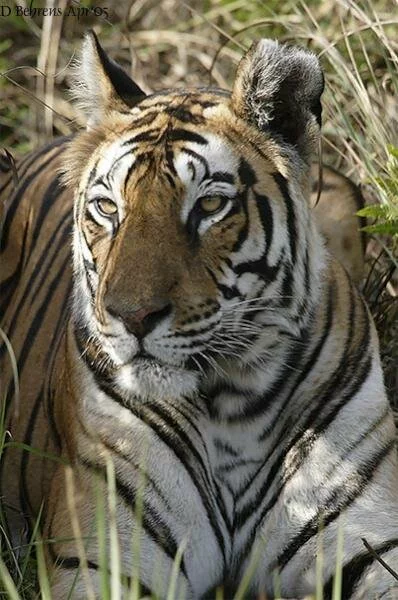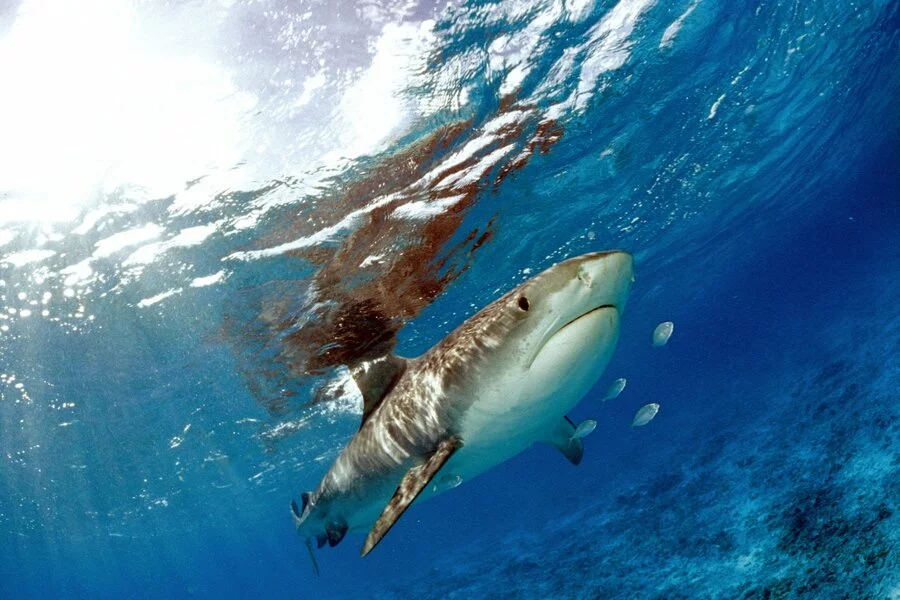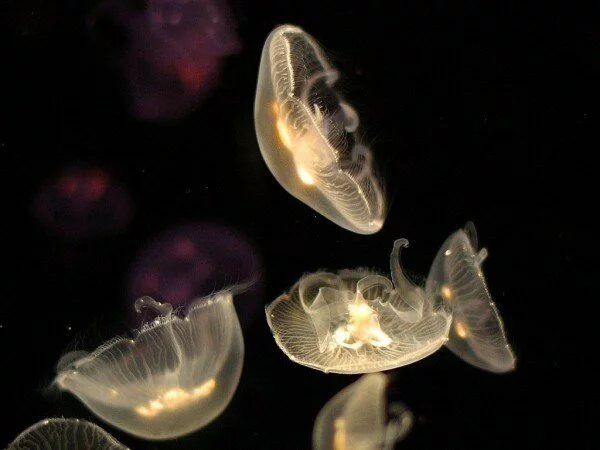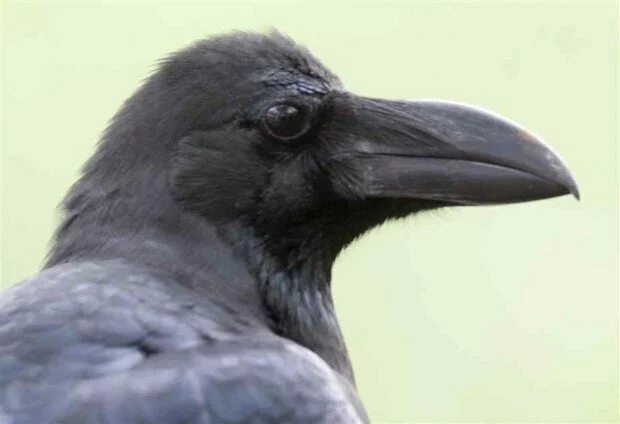Dangerous Neighbors Part 2: African Lions and Spotted Hyenas
Deep within one of Africa’s vast savannahs, a small pride of lions has recently managed to kill a large buffalo. The pride had gone for quite some time without sufficient food, but the tenacity and hard work of its members has finally led to a kill. The lions are nearly breathless from the chase, and lie down to regain their energy before enjoying their new meal. However, another group of hunters was alerted by the activity of the hunt. Attracted by the scent of fresh blood, this new group of predators is excited and seeks out the chance of obtaining a free meal. They emerge from the tall savannah grass, intentionally making their presence known to the lions. Yet what creatures would dare attempt to challenge the large and powerful lions? As more and more of these confident creatures appear at the site, it becomes clear that it may be the lions which are in danger. Though the intruders are smaller than the lions, they outnumber the big cats and appear confident. These challengers are among the lions’ greatest natural competitors, the cunning and deadly spotted hyenas. They have their eyes set on the recently killed buffalo, with no intention of retreating. The lion pride, though exhausted from the hunt, boldly stands its ground. Both groups brace themselves, as neither can afford to sacrifice such a large meal. Suddenly, one of the lions dashes towards the hyenas, with its pride members following closely behind. The hyenas, reassured by the support of their fellow clan members, disperse their group in an attempt to surround and overwhelm the small lion pride. As such, a great struggle begins in order to determine who eats and who starves. These battles are not particularly rare; in the African wilderness there is a constant struggle to survive among creatures. Even the king of beasts is not free of competition in these dangerous lands, and hyenas are possibly the most common competitors against lions. Since both predators rely mainly on the same prey for food, these animals are eventually forced to clash in potentially mortal battles as they attempt to dominate each other over food. They truly are dangerous neighbors.
Lions and hyenas are both important predators in their natural habitat. Along with other predators, they aid in the control of prey numbers. This keeps herbivorous species from overpopulating and causing damage to the environment, as well as ensuring that only the strongest and healthiest of herbivores survive (the old, sick, and/or weak are usually targeted by predators in order to lower the risk of injury during a hunt). However, lions are larger and more powerful than hyenas, which means that the felines can tackle larger prey more often than hyenas usually can. Their size and great strength also make lions the apex predators of their environment.
Few creatures would dare to confront a full grown lion. A male African lion (Panthera leo) can grow to lengths of 8 feet and measure up to 4 feet high at the shoulders. The largest males can also reach a weight of up to 500 lbs. Females are smaller (though still quite large), measuring up to 5.5 feet in length and 3.5 feet in shoulder height while commonly weighing no more than 395 lbs.[1] Their large sizes, along with the fact that lions are rarely alone, make these predators among the most dangerous of Africa’s wildlife.
A lion pride can consist of anywhere from 2 to 40 members. However, it is rare for all members of a pride to be present in one location since many members will come and go as they wish.[2] Overall, the average lion pride will consist of 15 individuals. The leaders of these prides are no strangers to combat, as they only acquired their roles as dominant lions by driving away (or killing) the pride’s previous male (or males).[3] The strongest prides are those which possess the greatest number of lions, as this allows them to not only acquire food more easily, but also to protect their territory more effectively. Put simply, a sizable pride is an immediate danger to even the largest of animals.
It is this social behavior which has allowed lions to become among the most successful predators in the world. By laying low and relying on camouflage to keep them concealed, lionesses can make their way to a herd of animals without being spotted. Once a certain animal is targeted (usually an old, sick, or injured creature), the lions spring out from cover and rapidly sprint towards their target. Although the entire herd is alerted and scatters, the lions continue to pursue their chosen prey. Despite their large size, these powerful cats can reach a maximum speed of 50 mph.[4] However, their prey can be even faster, and so cooperation is necessary for a successful hunt. This is where the pride’s other members come in. The lionesses will often force their target to move into a certain area, where the remaining female hunters await the approaching target. Once the prey makes its way into the trap, the hidden lions dash out and attack their prey.[5] Should one of the lions manage to sink its claws into the fleeing animal, it will use all of its strength to bring down to animal. At this point, the victim has lost all hope of survival; within seconds, the rest of the pride is on the scene to assist in the kill. One of the lions kills the downed animal by clamping its powerful jaws around the neck or nasal area of its prey in an attempt to kill the animal via asphyxia or cerebral ischemia.[6] Within a short span of time, the prey is dead and the lions can begin to feast.
It is this combination of cooperation and power that led to the lion’s success. The big cats proved to be effective hunters as their numbers grew and they ventured into new locations. Indeed, at the peak of their success, these mighty hunters could be found in most of Africa as well as in parts of Europe and Asia. Today lions can only be found in parts of sub-Saharan Africa, although there also remains a small population of Asian lions in India’s Gir Forest as well.[7]
What about the spotted hyena? Can these smaller creatures truly compete with sheer power and lethality that a lion pride exudes? Well, spotted hyenas (Crocuta crocuta) are actually excellent hunters in their own right. At about 5 feet in length and 190 lbs at the heaviest (with females being the larger of the sexes), a lone spotted hyena may not strike fear in some of Africa’s larger animals.[8] However, just like lions, hyenas are also social creatures. While a pride of lions is considered large when it contains 30-40 members, a group of hyenas (also known as a clan) can consist of up to 80 animals. This, along with the fact that hyenas can be quite aggressive and possess extremely powerful jaws, makes these creatures deadly to any of Africa’s other predators.[9]
The spotted hyena’s social structure is fairly different from that of lions. In a hyena clan, it is the females which are dominant.[10] Like lions, however, males leave their original clans and must find a new group oh hyenas to join. A new male enters a dominance queue and slowly works himself up the clan ranks as time passes while also gaining the favor of the larger females by following them for long periods of time. The females, apart from possessing dominance over all the males, have a rank-based of their own. Particularly high ranking females begin associating more with kin than those of lower ranks. This is thought to aid in hunts, scavenging, and attacks on unrelated females.[11] After all, a large group of hyenas will always be more effective in food gathering than smaller groups.
Hyenas will often use their numbers to aid them in isolating and overcoming their prey, which include animals such as antelopes and wildebeest. Once hyenas have overpowered and killed their prey, they consume everything. Not even bones and hooves are left behind, as the hyenas’ powerful jaws allow them to crush even these tough materials.[12] However, they cannot fully digest the hair, horns, and hooves of their prey, and so they regurgitate these materials in the form of small pellets.[13] Despite its size, the hyena truly is an impressive predator.
A large clan is more than just effective for hunting. Hyenas are known for obtaining much of their nutrition from scavenging, which saves them the trouble of hunting their own food. Scavenging is not necessarily a safe tactic, though. Hyenas are not the only carnivores looking for an easy meal; wild dogs, cheetahs, leopards, and, indeed, even lions will not turn down the opportunity to feast upon a carcass. Using their numbers and powerful jaws, hyenas can easily drive away many predators. Lions, however, can prove more troublesome than wild dogs or the smaller felines. Attacks on lion prides can be extremely risky for hyenas if there are too many lions in the area. However, the presence of risks is not enough to deter many hyena clans, which can prove to be deadly even to the “king of beasts.”
Since spotted hyenas and lions occupy the same ecological roles in their natural habitat, competition between the two animals is unavoidable. Furthermore, with both being aggressive animals which travel in groups, competition between lions and hyenas can become hectic quite easily. Both species are known to steal kills from each other, though lions will actively search out hyenas upon recognizing their feeding calls.[14] Hyenas may sometimes have no choice but to temporarily discontinue feeding and allow the much larger lions to eat, especially when the lions are too numerous to risk attacking. A group of lions consisting of only lionesses is more likely to be attacked by a sufficiently large clan of hyenas, as the smaller female cats are somewhat more vulnerable than the bulkier male lions.[15] Should one or more male lions appear at the scene, it would be within the best interests of the hyenas to retreat and simply wait for the lions to finish eating their fill.
Interactions between the animals take place in more than just carcass locations. Interestingly enough, both species have been known to react with hostility to each other for no apparent reason. Lions, in particular, have been known to maul nearby hyenas without consuming them.[16] However, actual predation by lions does occur and hyenas have been known to react to this predatory behavior by reacting aggressively to any lions which approach their territories.[17] The hyenas mob the intruding lions and attack them, which deters the lions from approaching them in the future. The most extreme cases of hostility between lions and hyenas may resemble a form of animal warfare, and such cases have actually been observed. One case in April, 1999 in Ethiopia consisted of a two-week long struggle between lions and hyenas which resulted in the deaths of 6 lions and 35 hyenas.[18]
This competition, though violent and seemingly pointless, is actually quite beneficial. In the case of the relationship lions and hyenas share, lions are the more dominant carnivores. During struggles between both animals, it is more common for a lion to kill a hyena. As a result, this interspecific struggle tends to results in the regulation of hyena populations. However, lions are also a source of scavenging opportunities for large clans of hyenas. Therefore, it is not an entirely negative relationship for the spotted hyena. There are factors which alter the intensity of this natural competition, as well. Among the greatest influences is the local prey density in areas where lions and hyenas coexist. In some cases, the high abundance of prey animals can result in less of a need for scavenging. However, in the case of lions and hyenas, violent struggles are often for the remains of carcasses. Here, a heightened abundance of prey can potentially increase the intensity of interspecific competition. Other factors, such as habitat and prey preferences, can also affect this behavior.[19] This all adds up to create a complex ecological system which has yet to be entirely understood by scientists.
Yet it is this complex system which allows for the strongest of animals to survive. The interactions between these two fearsome predators are truly among the most interesting of ecological relationships. Though this behavior can lead to violent battles between both animals, it is also relationship which can be beneficial for both species. It is one of the many relationships which allows for a healthy, thriving ecosystem.
[1] “AFRICAN LION.” www.seaworld.org. Available from http://www.seaworld.org/animal-info/animal-bytes/animalia/eumetazoa/coelomates/deuterostomes/chordata/craniata/mammalia/carnivora/african-lion.htm. Internet; accessed 9 July 2011.
[2] “Panthera leo.” www.animaldiversity.ummz.umich.edu. Available from http://animaldiversity.ummz.umich.edu/site/accounts/information/Panthera_leo.html. Internet; accessed 9 July 2011.
[3] “Lion, The King of the Jungle.” www.lions.org. Available from http://www.lions.org/lion-the-animal.html. Internet; accessed 9 July 2011.
[4] “African Lion.” www.defenders.org. Available from http://www.defenders.org/wildlife_and_habitat/wildlife/lion.php. Internet; accessed 9 July 2011.
[5] “More information on Lions.” www.lions.org. Available from http://www.lions.org/lion-the-animal-more.html. Internet; accessed 9 July 2011.
[6] “About lions – Ecology and behaviour.” www.african-lion.org. Available from http://www.african-lion.org/lions_e.htm. Internet; accessed 9 July 2011.
[7] “African Lion .” www.animals.nationalgeographic.com. Available from http://animals.nationalgeographic.com/animals/mammals/african-lion.html. Internet; accessed 9 July 2011.
[8] “Spotted Hyena .” www.animals.nationalgeographic.com. Available from http://animals.nationalgeographic.com/animals/mammals/hyena.html. Internet; accessed 10 July 2011.
[9] “Crocuta crocuta.” www.ummz.umich.edu. Available from http://animaldiversity.ummz.umich.edu/site/accounts/information/Crocuta_crocuta.html. Internet; accessed 10 July 2011.
[10] “Spotted Hyena .” www.animals.nationalgeographic.com. Available from http://animals.nationalgeographic.com/animals/mammals/hyena.html. Internet; accessed 10 July 2011.
[11] “Crocuta crocuta.” www.ummz.umich.edu. Available from http://animaldiversity.ummz.umich.edu/site/accounts/information/Crocuta_crocuta.html. Internet; accessed 10 July 2011.
[12] “SPOTTED HYENA FACTS.” www.animal.discovery.com. Available from http://animal.discovery.com/fansites/wildkingdom/hyena-princess/hyena-facts.html. Internet; accessed 10 July 2011.
[13] “Hyena.” www.awf.org. Available from http://www.awf.org/content/wildlife/detail/hyena. Internet; accessed 10 July 2011.
[14] Interactions between Hyenas and other Carnivorous Animals in Kruuk (1972)
[15] Cooper, S.M.. “Optimal hunting group size: the need for lions to defend their kills against loss to spotted hyaenas.” African Journal of Ecology 29 no. 2 (2008): 130-136
[16] Dereck and Beverley Joubert. (1992). Eternal Enemies: Lions and Hyenas. [DVD]. National Geographic.
[17] Trinkel, Martina; Kastberger, Gerald. “”Competitive interactions between spotted hyenas and lions in the Etosha National Park, Namibia”.” African Journal of Ecology 43 no. 3 (2005): 220-224.
[18] Denis-Huot, Christine; Denis-Huot, Michel. The Art of being a Lion. White Star Publishers, 2002.
[19] “Interspecific Competition and Anti-predator behavior.” www.hyenas,zoology.msu.edu. Available from http://hyenas.zoology.msu.edu/research/crocuta/interspecific-competition-and-anti-predator-behavior.html. Internet; accessed 10 July 2011.



